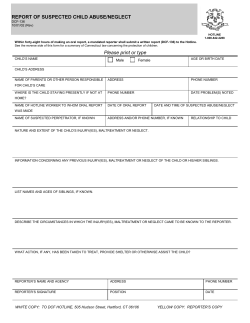
A C T H E E S T
F A C T SH E E T Prevent Child Abuse New York Prevention Information Resource Center 24-Hour Helpline: 1-800-342-PIRC (7472) 1 Recognizing Emotional Abuse Emotional Abuse Emotional abuse includes parents’ or caretakers’ acts or omissions that cause or could cause serious conduct, cognitive, affective, or other mental disorders. For example, torture, close confinement or the constant use of verbally abusive language to harshly criticize and denigrate a child. Emotional Neglect It also includes emotional neglect—withholding physical and emotional contact to the detriment of the child’s normal emotional development, and in extreme cases, physical development. Warning Signs The behavior of parents and children can offers clues to what may be occurring in the home. A parent or caregiver may be emotionally abusing a child if they routinely: • • • • • • Ridicule the child and mock the child’s appearance, ideas, abilities, fears or accomplishments. Criticize the child and undermine the child’s confidence and feelings of self-worth with cruel remarks such as, “You are no good,” or “You should have never been born.” Terrorize the child by yelling repeatedly, threatening to beat or abandon the child, or exposing the child to family violence. Reject the child by consistently denying affection or clearly favoring a sibling. Humiliate the child or shame the child in front of others as a form of discipline. Blame the child without cause or make the child feel responsible for anything that goes wrong. A parent or caregiver may be emotionally neglecting a child if they routinely: • • • • Fail to show interest in the child’s thoughts, feelings, or activities. Withhold affection when the child falls short of the parent’s unrealistic expectations. Fail to express warmth or tenderness to the child. Isolate the child and refuse to allow the child to interact with others. 33 Elk Street, 2nd Floor | Albany, NY 12207 P: 518-445-1273 | F: 518-436-5889 www.preventchildabuseny.org info@preventchildabuseny.org Prevent Child Abuse New York Prevention Information Resource Center 24-Hour Helpline: 1-800-342-PIRC (7472) Physical indicators F A C T S H E E T 2 Emotional maltreatment can be difficult to detect. The following physical and behavioral indicators do not always imply abuse and neglect, but adults should be concerned if a child regularly exhibits several of indicators. Physical indicators of emotional maltreatment: physical developmental delays, wetting of bed or pants, speech disorders, health problems such as ulcers, asthma, or skin disorders, severe allergies, obesity, extreme weight loss or gain, or poor appearance Behavioral indicators Behavioral indicators of emotional maltreatment: habit disorders such as sucking, biting, or rocking, destructive behavior to self and/or others, depression, extremes in behavior, aggressive or withdrawn behavior, phobias, sleep disorders, mental or emotional developmental delays, anti-social behavior such as cruelty, vandalism, stealing, or cheating, learning disorders, inappropriately adult or infantile behavior, suicidal thoughts or actions Reporting emotional abuse It may be necessary to file a report of child abuse and neglect with the reporting hotline at the New York State Central Register of Child Abuse and Maltreatment. The number is 1-800-3423720. They will notify the local Child Protective Services (CPS), which is part of the county Department of Social Services. The reason to make a report is to get help for the child and the family. CPS will investigate and take needed action to protect the child and to help the parent(s) solve problems which are leading to violence, abuse, and neglect. Help is available If you or someone you know needs help, the Prevention Information Resource Center and Parent Helpline is available throughout New York State, 24 hours a day, in English and Spanish at 1-800-342-7472. Someone will listen to your concerns and give you information about programs and services that help and support parents and children. 33 Elk Street, 2nd Floor | Albany, NY 12207 P: 518-445-1273 | F: 518-436-5889 www.preventchildabuseny.org info@preventchildabuseny.org
© Copyright 2025





















